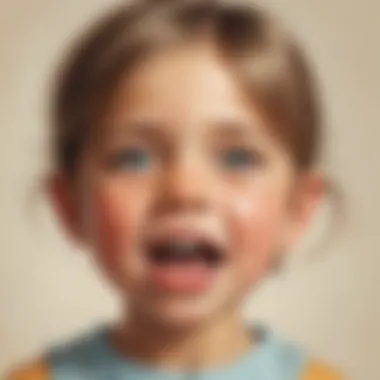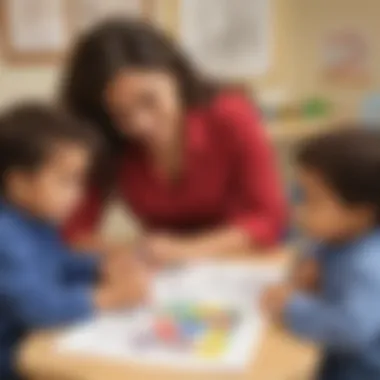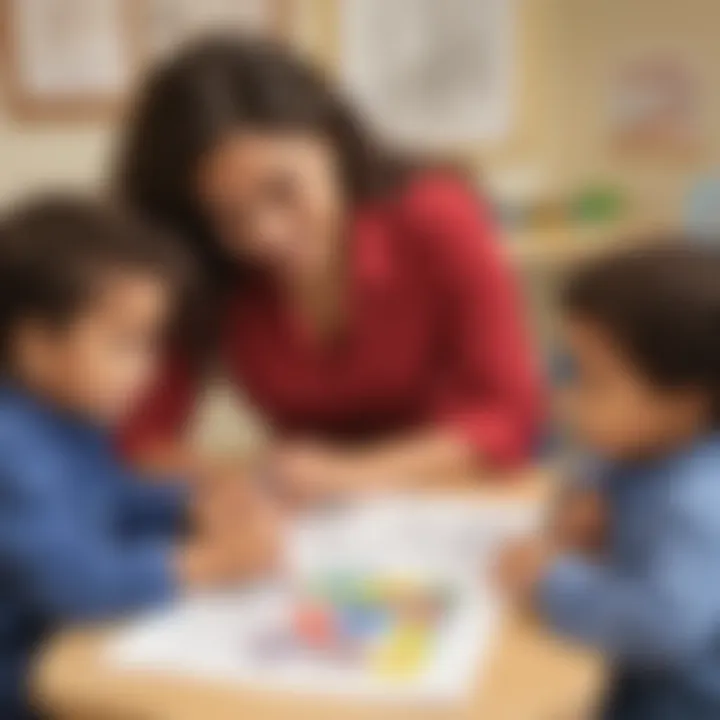Exploring Pre-K Drawings: Insights into Young Minds


Intro
Understanding pre-K drawings offers a valuable glimpse into how young minds think and feel. Children express emotions, thoughts, and creativity when they draw. These simple lines and colors can hold meanings beyond their appearances. Parents and educators can benefit from exploring these artistic creations.
Science Fun Facts
Exploring children's art can also lead to surprising discoveries. Here are a few intriguing facts about young artists and their drawings:
- Color Choice: Studies show that children often choose colors based on feelings. For example, bright colors can indicate happiness, while darker shades might suggest sadness.
- Space and Form: Children's visual perception evolves quickly. Initially, they may draw simple shapes before moving to more complex figures when they gain spatial understanding.
- Imaginary Friends: Many children draw creatures or people that do not exist in reality. This reflects their imagination and ability to create narratives.
The act of drawing can help enhance fine motor skills. This is crucial for various daily tasks.
- Cognitive Abilities: The progression in drawing skills often parallels cognitive growth. With time, children start to add details and understand proportions better.
Collectively, these facts highlight the profound significance of pre-K drawings in revealing developmental milestones. The journey through these early years of creative expression assists in facilitating an overall understanding of the child's inner world.
Preamble to Pre-K Drawings
Pre-kindergarten drawings serve as a fascinating insight into the minds of young children. These early art expressions not just display creativity but are crucial for understanding their cognitive and emotional development. The process of drawing engages multiple critical skill areas including fine motor skills, creativity, and method of expression. Through art, children communicate ideas and feelings that may be difficult to verbalize.
Recognizing the fundamental nature of pre-K drawings allows parents and educators to support childrens' growth in more effective ways. Observing what children choose to draw can uncover their interests and emotions.
What Are Pre-K Drawings?
Pre-K drawings can be defined as creations made by children usually aged 4 to 6 years. At this stage, kids often use simple lines, shapes, and colors to represent their perception of the world oko them. These drawings are often spontaneous and lack significant detail, reflecting the child's current level of cognitive functioning.
Items may seem less realistic, but it is important to recognize that these artistic pieces illustrate their unique understanding. Often, children's art is filled with colors they prefer, showcasing their personal choices.
Historical Context of Children's Art
Understanding pre-K drawings also requires a consideration of historical contexts. Throughout history, children's art has attracted attention not only for its aesthetic appeal but also for insights into child development. Such creativity can be noted as being quite intuitive. It has been found that various cultures around the world have recognized the significance of children’s art as a way of preserving culture.
Research shows that in past centuries, children often began drawing as a form of play. This play can relate to social interactions, exploration, and environmental factors. Parents and educators should view these pieces not just as simple doodles but as rich reflections of a time both progressive and enlightening for cognitive skills.
"The act of drawing is a form of language through which children communicate their thoughts and feelings."
Ultimately, pre-K drawings echo the time period and cultural backdrop pupils are immersed in, thus offering a deeper understanding of children's evolving cognitive skills.
Cognitive Development and Art
Understanding the relationship between cognitive development and art is crucial when analyzing pre-K drawings. Art offers a unique lens to explore how young minds formulate their thoughts and feelings. It serves as an indicator of children's growth in different cognitive areas. Engaging in artistic activities encourages children to develop skills in critical thinking, problem-solving, and creativity.
Understanding Cognitive Stages
Cognitive development occurs in stages that are progressively complex. Jean Piaget, a leading figure in childhood development theory, identified clear stages displaying how children’s understanding of the world grows. In the pre-K period, children primarily operate in the preoperational stage. At this age, children's thinking is intuitive rather than logical. They begin to form mental representations of objects and ideas, allowing their artwork to emerge in tandem.
During this stage, the drawings tend to reflect the child's immediate environment and their experiences. For instance, a toddler might portray their family members using simplified forms. Understanding these cognitive stages offers important insights into interpreting pre-K artwork.
- Children often depict things as they wish them to be rather than how they are.
- Artworks become a form of experimentation where children make sense of reality may lead to some error in representation.
As a child creates their art, it functions both as a therapeutic tool and as a means of learning how to organize their thoughts.
Symbolic Thinking in Drawings
Symbolic thinking plays a pivotal role in children's drawings. As they transition through early childhood, their understanding evolves. Artwork becomes a method for them to visualize thoughts that they cannot yet express verbally. When children use symbols in their art, they reflect on their world and experiences, marking key moments of cognitive progress.
In pre-K art, symbols are often personal and can seem random to older people but hold meaning for the child. For example, a round circle with lines may stand for the sun, or a series of colors and shapes may depict a story only the child can describe.
- Key insights of symbolic thinking in drawings:
- Visual language: Children develop a visual language before they acquire language skills.
- Emotional processing: Drawings are tools to express ideas or emotions that are difficult to communicate with words.
- Understanding complexities: As they grow, children's symbolic representations become more coordinated and representative.
The use of symbols allows children to connect with their environment. This connection lays the groundwork for further creative development and cognitive capabilities. By examining pre-K drawings through the lens of cognitive development and symbolic thinking, educators and families can better appreciate the cognitive strides that accompany artistic exploration.
"Art enables us to find ourselves and lose ourselves at the same time."
– Thomas Merton
In ensuring environments where artistic expression thrives, parents and educators can reinforce both cognitive and emotional growth through child-led art experiences.
Emotional Expression Through Art


Art serves as a powerful medium for emotional expression, especially in the context of pre-K drawings. Young children often struggle to articulate their feelings verbally. Through art, they can convey complex emotions in ways that words may fail to capture. By studying these drawings, parents and educators can gain valuable insights into the inner worlds of children. Understanding the fundamental role of emotions in art allows for nurturing children's emotional development effectively.
Identifying Emotions in Drawings
Interpreting children's drawings can reveal a broad spectrum of emotions. Color choices can reflect how a child feels. For example, bright colors might indicate joy, while darker shades might suggest sadness or anger. Additionally, the themes or subjects depicted can offer clues. A child may draw family members when feeling secure and loved or a more chaotic image during times of stress or distress.
Carefully observing techniques used in the drawing could be honest indicators of the conditions of the child's inner world. Lines may be softer when a child is relaxed or intense and sharp if they are expressing frustration or anger. Such analysis enhances the understanding of children's emotions.
It is important to note that emotional interpretation may vary per child. Familiarizing oneself with a child's personality will also aid in accurately identifying emotions. What is significant is drawing parallels and reflecting feelings back to the child, sparking discussions.
Art as a Form of Communication
In the context of pre-K education, art offers a unique linguistic alternative. Many nonverbal children utilize drawing to communicate their obsessions and experiences. This silent discourse is rich with meaning, providing educators and caregivers a glimpse into a child's thoughts when traditional communication avenues aren't available.
Through art, children often find a unique freedom to express their thoughts and experiences without fearing misinterpretation. This process fosters self-expression, builds self-esteem, and enhances communication skills over time. Children are more inclined to share their drawings than speak about them. This becomes a constructive practice of discussing feelings based on visual artworks.
Drawing encourages children to reflect on personal experiences, allowing connection with peers and adults. Reflection may emerge through dialog with parents or by reviewing their drawings with teachers. It also nurtures a child's identity through active participation in creative expression.
Art becomes a bridge toward understanding other perspectives, encouraging empathetic communication.
Epilogue
Emotional expression through art plays a vital role in a child's development. Recognizing emotions in drawings and appreciating the communicative aspects of art can nurture self-awareness and understanding. Supporting a child's expression provides numerous benefits that extend into their broader development, both intellectually and emotionally.
Common Themes in Pre-K Art
Pre-K drawings are vital in understanding common themes that recur among young artists. Such themes allow adults to decode children’s thoughts, imaginations, and social worlds. Children’s artwork is more than just colors and shapes; it reflects their experiences, values, and emotional landscapes. Teachers and caregivers should pay attention to these common themes, as they inform general development trends and help in nurturing creativity.
Nature and Environment
The theme of nature and environment often emerges in the art of young children. Children relate to the natural world as they explore their surroundings. Their fascination with living creatures, plants, and natural phenomena shapes their artistic expressions. When kids draw trees, animals, or landscapes, they convey their observation and interactions with nature. This theme fosters a connection between children and their environment, promoting early ecological awareness and responsibility.
Research indicates that engaging with nature can enhance cognitive development. Children who often depict nature in their art are likely processing their experiences and forming a foundation for environmental understanding.
Popular drawing subjects include:
- Birds in various colors
- Flowers of assorted sizes and shapes
- Sunsets or starry skies, showing fascination with astronomy
These subjects motivate children's creativity and self-expression. Furthermore, art involving nature prompts discussions which can be beneficial for both artistic expression and science education.
Family and Social Interactions
Families are central figures in the lives of young children. As such, the portrayal of family dynamics is a frequent theme in many pre-K drawings. Children often draw family members engaged in various activities, signifying their relationships and roles within the unit.
These drawings provide a glimpse into their perception of home, community, and social interactions. For parents and educators, analyzing these representations can deepen their insight into how children view and relate to familial structures. Phrases can emerge in discussions to help children articulate how they feel, increasing their emotional intelligence.
Some specific examples include:
- Scenes of family gatherings or outings
- Representation of pets alongside family members
- Abstract concepts such as love or happiness depicted using colors and shapes
Such themes support emotional development, encouraging children to express their feelings and understand varying perspectives in a family.
Imaginary Worlds and Fantasy
The fascination with imaginary worlds reveals the depth of creative thinking in young children. Their art journeys into fantasies that display innate imagination and problem-solving capabilities. Through illustrations like dragons, superheroes, or space adventures, children bring their dreams and fears to life on paper.
Imaginary themes are essential. They reflect children’s understanding of reality, boundaries, and societal norms. The blending of real and fantastical elements is a hallmark of this age. Young artists create a narrative that allows exploration, potential, and even conflict resolution.
Some common imaginary motifs seen in pre-K drawings are:
- Magical creatures such as unicorns or fairies
- Explorations of outer space, including planets and aliens
- An amalgamation of various cultural folklore and fairy tales
These themes not only provide an outlet for creative thought but also enhance storytelling habits. They present opportunities for parents and educators to engage in discussions about creativity and cultural narratives.
Techniques and Tools Used by Pre-K Artists
Art creation in pre-K is not just about putting colors on paper; it involves a range of techniques and tools that contribute significantly to children’s development. By using various art materials, young children express their thoughts and feelings while also enhancing their motor skills, creativity, and capacity for communication.
In examining the tools that children employ and the techniques they utilize, one can better appreciate how each element informs their ability to interact with the world around them. Understanding this subject is crucial for parents and educators alike, as it illuminates the impact of facilitating art experiences on personal growth.


Color Preferences and Their Meanings
Colors have a distinctive place in the art of children. Different hues can signify various emotions or concepts in their drawings. For instance, a child may predominantly use blue during a quiet phase, while a sudden explosion of reds or yellows could correlate with a burst of energy or excitement.
Here are some interpretations of common color preferences:
- Red: Often linked to passion or anger, it can indicate powerful feelings when used abundantly in a drawing.
- Blue: Typically signals calmness or sadness, frequent use might suggest that a child is longing for comfort or tranquility.
- Green: Associated with nature, growth, and life; its use can reflect thoughts about environment.
Also, repeated use of certain colors may uncover the child’s preferences and spirit. Such insights can assist adults in understanding the emotional landscape of young minds.
Drawing Tools: Crayons, Markers, and More
Children’s choice of tools is an integral part of their drawing experience. Each medium offers unique benefits that can promote different skills:
- Crayons: These are staple tools that foster creativity and dexterity. Using crayons involves different pressure and movements which enhance motor skills.
- Markers: With their watery ink, markers allow for more vivid expressions. Children are attracted to the bold, bright colors that can function well for strong emotional statements in their work.
- Colored Pencils: With precision control, these tools help children develop fine motor skills while offering a nuanced choice of shading.
Choosing the right tools should be tailored for developmental goals. Diversity in mediums offers diverse expressions, broadening understanding and connection.
Overall, emphasizing these techniques and materials helps amplify the overall purpose of art within child development. Through their creative endeavors, children learn more about themselves and their world.
Educational Frameworks Supporting Artistic Expression
The integration of educational frameworks that promote artistic expression is crucial for enhancing children's developmental journey. Art serves not only as a medium for creative output but also plays a significant role in various aspects of learning. Within pre-K environments, fostering artistic expression establishes a foundation for critical thinking, problem-solving abilities, and emotional intelligence.
One important aspect to consider is the connection between art and education. Incorporating artistic elements into the curriculum facilitates multidimensional learning, allowing children to engage with concepts in a practical and stimulating way. This integration helps develop imagination and encourages self-expression, serving as a vital tool in today’s education system.
For instance, when children engage in drawing or crafting during classroom time, they also sharpen fine motor skills and hand-eye coordination. By providing a versatile approach to learning, educators can examine the broader benefits:
- Encouragement of creativity: When artistry is a constant, children can explore endless possibilities which boost innovation.
- Holistic development: Curriculums encompassing art nurture students’ emotional, social, and cognitive development.
- Enhanced engagement: Children participating in creative activities show increased motivation and enthusiasm toward learning topics and material.
Therefore, it's essential to understand that integrating art into education is more than just adding a fun activity; it's about recognizing the role of creativity as a requirement for a well-rounded education.
Curriculum Integration of Art
Curriculum integration at pre-K levels involves situating creative activities within thematic units that resonate with children's experiences. For example, when introducing a unit on seasons, teachers may include activities where children create drawings that reflect the different weather patterns and natural changes throughout the year. This combination not only makes learning dynamic but also assists in reinforcing key concepts while allowing the children to express themselves creatively.
An organized curriculum typically features:
- Artistic projects linked with educational goals: Aligning drawing tasks related to stories or subject matter promotes understanding.
- Diverse media usage: Providing a variety of materials, such as paint, clay, or collage, offers broader artistic experiences for students.
Thus, curriculum integration helps students grasp more abstract concepts through tangible and visually stimulating means while enhancing various learning styles.
Art as a Learning Tool
Art, in its many forms, serves as a fundamental learning tool that guides children towards deeper understanding and retention of knowledge. Engaging in art not only provides enjoyment, it also stimulates critical thinking and enhances problem-solving capabilities. Activities that require decision-making, like selecting colors or planning compositions, involve cognitive engagement that is critical for early childhood education.
Art also functions as:
- A reflection of thought processes: Children communicate their understanding and survey the world through the lens of their artwork.
- A bridge for interdisciplinary learning: For instance, a simple painting activity can teach concepts from science, such as color mixing or life cycles with associated themes.
Importantly, availability of adequate materials to create art is crucial in educational settings. Access to crayons, watercolors, and paper empowers the students to be innovative and express ideas visually. This practice keeps students motivated and eager for exploration in classrooms, fostering a prolonged love for learning.
In summary, educational frameworks that support artistic expression serve a pivotal role in early childhood education. They encourage multidisciplinary engagement while facilitating cognitive abilities and emotional relationships with learning. Thus, understanding these frameworks aids parents and educators as they strive to cultivate rich learning environments for children.
The Role of Parents and Educators
Understanding pre-K drawings involves recognizing the pivotal role parents and educators play in nurturing young artists. Their involvement significantly influences a child's confidence, creativity, and overall emotional development. Additionally, they are vital in fostering an environment where artistic expressions flourish. Both crucial aspects encourage children to communicate their thoughts and feelings through art.
Encouraging Artistic Expression at Home
Parents can make a difference from the beginning by creating an inviting atmosphere at home for art. Providing easy access to art supplies like paper, colors, and brushes allows children to experiment freely. It supports their efforts to express through various mediums and pushes them to craft what they envision.
Here are a few practical strategies:
- Provide Variety: Have materials handy from crayons to watercolors, enabling diverse artistic experiences.
- Create Routine: Set aside regular times for art activities, making it a normalized part of daily life.
- Celebrate Creations: Display children's artwork prominently in the home. This validation increases their desire to express themselves creatively.
Children need encouragement to speak of their creations. Parents can ask open-ended questions like “What story does your picture tell?” This not only stimulates conversation but also promotes reflective thinking, a critical component in cognitive development. Encouraging them promotes a positive perception of their artistic capabilities, essential for growth.
Supporting Art in Educational Settings


In educational environments, supporting art is fundamental for overall development. Teachers should recognize that art is a means for expression and a pathway for cognitive growth. Integrating art into the curriculum allows for engaging diverse learning styles among the students. Engaging in properly structured art activities enhances motor skills, boosts concentration, and fosters social interactions.
Consider these methods for effective integration:
- Include Art Across Subjects: Connect art projects with other subjects like science, literature, or math. For instance, students can draw examples from nature when discussing ecosystems.
- Create a Safe Space: Develop an environment where creativity thrives without fear of critique. Children must feel safe to explore their ideas.
- Encourage Collaborative Projects: Group art activities promote teamwork and social skills. They help children realize the value of peer perspectives and shared creativity.
By recognizing and valuing children’s artistic efforts, parents and educators help form a foundation of confidence, emotional resilience, and cognitive ability.
Is it consistently recognized that an integrating approach has lifelong benefits, elevating children's chances of success beyond the realm of art. When educators and parents align in fostering artistic expression, the young minds flourish predominately, paving the way for holistic development.
Assessing Pre-K Drawings for Development Insights
Assessing pre-K drawings is a crucial aspect of understanding children's development. This topic is significant in recognizing how these creative works reflect cognitive and emotional growth. By analyzing drawings, adults can gain insight into a child's internal world. The assessment illuminates unique characteristics and experiences that can often remain unarticulated. It also facilitates ways to nurture those developing skills to align with educational and personal growth.
Interpreting Artistic Growth
Interpreting artistic growth in young children provides a clear pathway to understanding cognitive advancements. Children’s drawings evolve as they progress through developmental stages. For instance, the transition from random scribbles to recognizable shapes showcases how their fine motor skills develop alongside conceptual understanding. To interpret growth effectively, educators and parents must consider the following:
- Stages of Development: Each age group exhibits typical stages. Scribbling is predominant in younger years, while more defined forms begin to appear around age four. Familiarize with these stages to gauge progress accurately.
- Use of Color: The colors chosen can represent different feelings or moods. Bright colors may indicate happiness, while darker shades can express confusion or sadness.
- Subjects Depicted: Common subjects may reveal interests or fears. For instance, drawing a family can indicate a strong connection to family life, while a fantastical creature might suggest active imagination.
Understanding these factors allows for a deep assessment of not just art skills, but overall emotional and psychological well-being.
Identifying Areas for Support
Identifying areas for support is another crucial dimension of assessing pre-K drawings. This process involves looking for specific elements that indicate a need for enhancement or intervention. Important considerations include:
- Repetitive Themes: If a child repeatedly draws certain subjects or scenarios, it might signal something significant. For example, persistent negative themes could hint at underlying anxiety.
- Lack of Detail: Children may avoid intricate features if unsure about their skills or if they feel overwhelmed. Offering encouragement can help in boosting their confidence to explore more complexity in future works.
- Exploring Materials: The choice of drawing tools can impact expression. Encouraging the use of various media, including crayons, markers, and paints, could provide a broader spectrum for creative expression.
In supporting a child's artistic journey, it is essential for parents and educators to create environments where exploration is encouraged. This can enhance both creativity and emotional expression. Building confidence in art can foster not just skills in drawing, but also improved communication abilities that benefit other areas of learning.
Challenges and Misconceptions
Exploring the challenges and misconceptions surrounding pre-K drawings is vital for understanding children's artistic development. These misunderstandings often lead to undervaluing the importance of children's art, while the real essence of these creations lies in what they reveal about the child's cognitive and emotional growth. Recognizing and addressing these misconceptions is crucial for both parents and educators. Here, we unpack common misunderstandings and the limitations seen in art education.
Common Misunderstandings About Children's Art
Many individuals tend to underestimate the depth and significance of children's art. One prevalent misconception is that all children draw the same way, indicating a lack of creativity. In reality, each child's artwork is unique and reflects their personal worldviews. Another misunderstanding is that simplistic drawings lack value. For instance, a child's depiction of a family can show not just how they see their loved ones but also their feelings and relationships. By interpreting these aspects, caregivers can gain major insights into a child's emotional status.
In contrast to these beliefs, children's art evolution is nuanced:
- Art is a process, not solely a product.
- Differences in children's artistic styles illustrate diverse cognitive development stages.
- The themes expressed can vary widely depending on environmental and cultural influences.
As such, it is essential to encourage free expression in art rather than pushing toward predefined standards.
Addressing Limitations in Art Education
Despite the clear benefits of art in early childhood development, there are limitations in art education that must be addressed. Curriculum often underscores technical skills over emotional and cognitive understanding, which diminishes the holistic view of a child's growth. Many educational programs also lack resources or trained staff to guide children in artistic explorations effectively. This lack of proper educational frameworks can stifle creativity and expression, leading to general misunderstanding about children’s inherent abilities.
To address these limitations:
- Educators should be trained to focus on emotional expression rather than just technique.
- Schools should integrate art more fully into their general education policies.
- Create more opportunities for collaboration that allow children to explore artistic identity.
By overcoming these challenges, we can support children's growth more effectively and enable them to convey their thoughts, feelings, and experiences through art.
To truly understand a child's development, one must appreciate the world viewed through their creative expression.
Concluding Thoughts on Pre-K Drawings
The act of observing and interpreting pre-K drawings goes beyond mere aesthetics. It offers profound insights into the developmental stages of young children. Central to understanding these artworks is recognition of the significant impact early art experiences have on cognitive and emotional growth. Pre-K drawings serve as visual narratives that encapsulate children’s perceptions, feelings, and interactions with their environments. The discussions and explorations within this article have showcased the invaluable role that art plays in enriching childhood development.
The Lasting Impact of Early Art Experiences
Engagement with artistic activities in early childhood leaves a lasting imprint on a child’s cognitive and emotional framework. Participating in art allows children to represent their ideas and experiences in a tangible form. This not only nurtures creativity but also cultivates problem-solving skills as they make decisions about their artistic expressions. The freedom inherent in creative endeavors encourages children to explore various avenues of self-expression. In doing so, it lays a solid foundation for critical thinking and emotional intelligence.
Early art experiences equip children with means to communicate their thoughts and emotions, thus impacting their relational skills as they grow.
Furthermore, regular engagement in artistic expression can enhance fine motor skills. Activities like drawing or using scissors facilitate wrist and finger movements. This can significantly contribute to later skills needed for writing and other directed tasks. Additionally, a positive artistic experience shapes children’s attitudes toward self-expression throughout their academic journey.
Future Directions in Art Education
As we reflect on pre-K drawings and their meaning, considering future directions in art education becomes essential. Our educational frameworks must adapt with changing understanding of child development. Instructing individuals on how to foster creativity should not only rely on traditional methods. Instead, it can incorporate mixed-media approaches involving digital platforms. Integrating technology can motivate young learners and make the experience more relevant to their world.
Moreover, teachers and parents must work collaboratively to create environments where art is encouraged. Spaces should be designed to not only stimulate creativity but also support emotional wellbeing. Encouraging open discussions about artworks—regardless of perceived skill or technique—fosters resilience and a growth mindset in young learners.
With clear understanding of the depth and value of children’s drawings, we can aspire toward nurturing imagination over skill alone. Recognizing the emotional and cognitive aspects rooted in artistic expression will guide effective practices in educationMoving forward, art education should remain responsive to the emergent needs of society. Focus on promoting reflection, critical exploration, and emotional growth in children clarifies the complex relationship they develop with art from an early age.
In summary, these concluding thoughts shed light on how crucial it is to prioritize early artistic engagement. Understanding and supporting pre-K drawings serves as a vital aspect in fostering comprehensive development in children.







